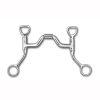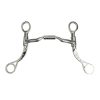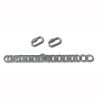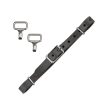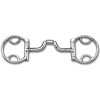Combination Bits
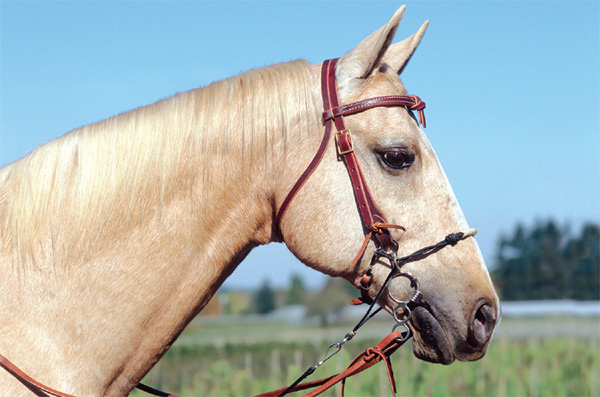
A combination bit is so named because it utilizes functional elements of both curb and snaffle bits. The primary goal of the combination bit is to expand the area of influence the rider or driver can bring to bear in order to gain more complete control over the horse. To this end an experienced rider can use it not only to correct problems such as head tossing but, when desired, to achieve more finely tuned or specific motion from the horse in general than wouldn’t be possible if employing only a snaffle or curb bit.
Some popular types of combination bits include:
- The Pelham – The Pelham bit utilizes two sets of reins; curb reins and snaffle reins, not unlike a double bridle. The snaffle rein is usually wider and the curb rein narrower in order to help the rider distinguish between the two. The Pelham has the mouthpiece, curb chain and shanks of any other curb bit but also the bit rings of the snaffle bit.
- The Kimberwicke – So named for the town in England where it was invented the Kimberwicke has bit shanks, a curb chain and D-shaped rings at the ends of the mouthpiece. Reins attached to the D-rings of a Kimberwicke are fixed in place, unlike a standard snaffle bit where the reins are allowed to float. Due to short purchase arms the shank leverage action is mild at best.
- The Liverpool – Slots along the shank allow for a variety of rein attachment configurations with the Liverpool bit. It is most often used in team situations where some degree of individual control over different horses may be required but the driver must be able to exert just one level of force and combine as many sets of reins as possible for the sake of practicality.
- The Gag Bit – The Gag bit is most often used for the correction of particular problems such as pulling or in situations where heightened control may be necessary. For the latter reason they are common sights at polo matches and show jumping events. They would not, however, be used during hunting or in other situations where having the head drawn back much of the time would be counterproductive. Gag bits are normally used with 2 sets of reins: one for the mouthpiece and one attached to rings that themselves attach to the headstall.
Enter the Myler Combination Bit
While the above bits all have their place and have served the equine community well for a long time the Myler brothers – Ron, Dale and Bob – were convinced they could find a better way to facilitate communication between horse and rider and set out to find just such a way. Years of research and experimentation finally coalesced in the Myler Combination Bit, a breakthrough in bit design that has quickly became the standard choice for many horse owners.
A unique hybrid of curb, snaffle and Hackamore design elements (although it must be said that the Myler Combination Bit is not a Hackamore or Hackamore combo) the Myler Combination Bit integrates the best of all three into a single apparatus that has won praise around the world for its low impact effectiveness. The great advantage of the Myler Combination Bit is its ability to bring mouthpiece, curb strap and noseband simultaneously to bear in the service of gentler, more humane and yes, more effective messaging.
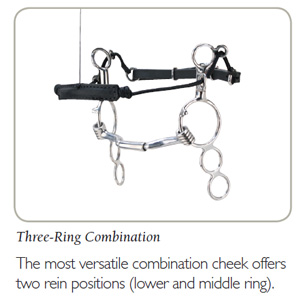
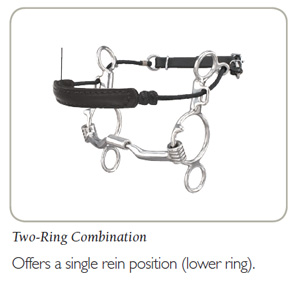
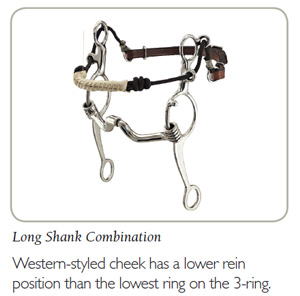
How It Works
It has been noted time and again that the Myler Combination Bit is perhaps the kindest bit you can buy, and it’s true. Designed to exert pressure by diffusing it over a wider area than conventional combination bits, it delivers a firm message free of unnecessary discomfort. Initial pressure is distributed between the nose, jaw and poll of the horse. If the rider continues to apply pressure the floating mouthpiece will engage the stop on the ring and pressure will be further distributed to the tongue and bars as well, enlarging the sphere of dynamic influence yet at the same time reducing pressure to each point on the array.
State of the art Myler Combination Bits employ all levels of Myler Sweet Iron mouthpieces renowned for their enlightened design which removes undue pressure from the horse’s tongue. (Sweet Iron erodes slowly in the horse’s mouth releasing a sweet taste the horse finds very appealing.) As a result the combination bit will adapt easily to any type of horse, from over-eager youngsters to experienced seniors. Professional riders as well have discovered the value of employing the Myler Combination Bit to relax their horses prior to important events.
The Myler Combination Bit represents perhaps the largest leap forward in horse bit concept and design in the modern era. It is the culmination of literally decades of experience, research, patient observation and just plain hard work by brothers Ron, Dale and Bob Myler who saw a troublesome issue with bit design and decided to do something about it.
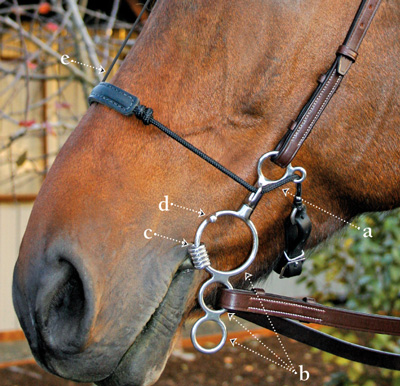
a. Noseband and chin strap are connected through the uniquely designed purchase
b. Three rein positions*: the big ring for direct rein action, the middle ring for fixed rein and a mild degree of leverage, and the bottom ring for fixed rein and moderate degree of leverage
c. The mouthpiece has a 1” slide, which works as a loose mouthpiece or warning, not a gag action
d. The stop engages the mouthpiece
e. The support string keeps the noseband level across the nose, even if the chin strap is loosened
*The other styles of combination bit only offer two rein positions

